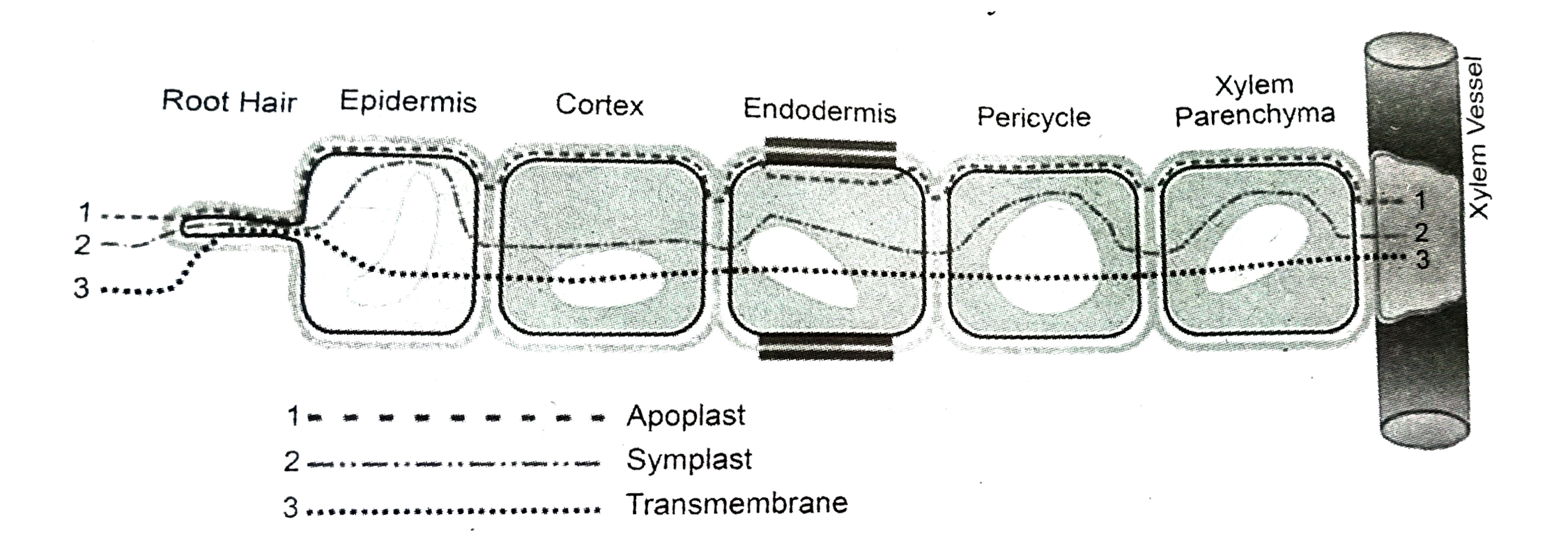Name the possible routes for the path of water across root cells. Solution in Tamil
There are three possible routes of water. They are i) Apoplast, ii) Symplast and iii) Transmembrane route.
1. Apoplast: The apoplast ( Greek: apo = away, plast = cell) consists of everything external to the plasma membrane of the living cell. The apoplast includes cell walls, extra cellular spaces and the interior of dead cells such as vessel elements and tracheids. In the apoplast pathway, water moves exclusively through the cell wall or the non-living part of the plant without crossing any membrane. The apoplast is a continuous system.

2. Symplast: The symplast ( Greek: sym = within, plast = cell) consists of the entire mass of cytosol of all the living cells in a plant, as well as the plasmodesmata, the cytoplasmic channel that interconnects them. In the symplastic route, water has to cross plasma membrane to enter the cytoplasm of outer root cell, then it will move within adjoining cytoplasm through plasmodesmata around the vacuoles without the necessity to cross more membrane, till it reaches xylem.
3. Transmembrane route: In transmembrane pathway water sequentially enters a cell on one side and exits from the cell on the other side. In this pathway, water crosses at least two membranes for each cell. Transport across the tonoplast is also involved.
Mechanism of Water Absorption Kramer ( 1949) recognized two distinct mechanisms which independently operate in the absorption of water in plants. They are, i ) active absorption ii) passive absorption.
Topper's Solved these Questions
- TRANSPORT IN PLANTS BOOK - FULL MARKSCHAPTER - TRANSPORT IN PLANTS EXERCISE - Additional Questions Solved (V). Higher Order Thinking Skills (HOTs))
6 Videos
- TRANSPORT IN PLANTS BOOK - FULL MARKSCHAPTER - TRANSPORT IN PLANTS EXERCISE - Additional Questions Solved (III. Short Answer Type Questions)
25 Videos
- TISSUE LEVEL OF ORGANISATION BOOK - FULL MARKSCHAPTER - TISSUE LEVEL OF ORGANISATION EXERCISE - ADDITIONAL QUESTIONS SOLVED (II. ANSWER THE FOLLOWING QUESTIONS)
17 Videos
- TRENDS IN ECONOMIC ZOOLOGYBOOK - FULL MARKSCHAPTER - TRENDS IN ECONOMIC ZOOLOGYEXERCISE - Additional Questions Solved ( Answer the following questions.)
99 Videos
Similar Questions
Why during rainy seasons, the wooden doors and windows are difficult to closs and open ? Give the phenomenon behind this and also define the phenomenon.
View SolutionDraw a Flow Chart illustrating various types of cell to cell transport .
View SolutionDefine tissues .
View SolutionWhat is Economic Zoology?
View SolutionBromobenzene can be dehydrobrominated to benzyne by three possible routes. Explain. Which paths are desirable ?
View SolutionIn root apoplast path of water transport is through
View SolutionName the possible routes for the path of water across root cells.
View SolutionExplain ' routes 's for path of water across root cells.
View Solutionपापवीय जल प्रवाह के विभिन्न मार्गों के नाम बताइए।
View Solutionजड़ों में अधिकांश जल का परिवहन किस पथ द्वारा होता है?
View Solutionपाश्र्वीय जल प्रवाह के विभिन्न मार्गों के नाम लिखिए।
View Solutionपार्श्वीय जल प्रवाह के विभिन्न मार्गो के नाम बताइए |
View Solutionजड़ो में जल का प्रवाह एपोप्लास्ट मार्ग से होता है क्योकि-
View SolutionExplain the types of parasitic mode of nutrition in angiosperms.
View SolutionName the possible routes for the path of water across root cells.
View Solution